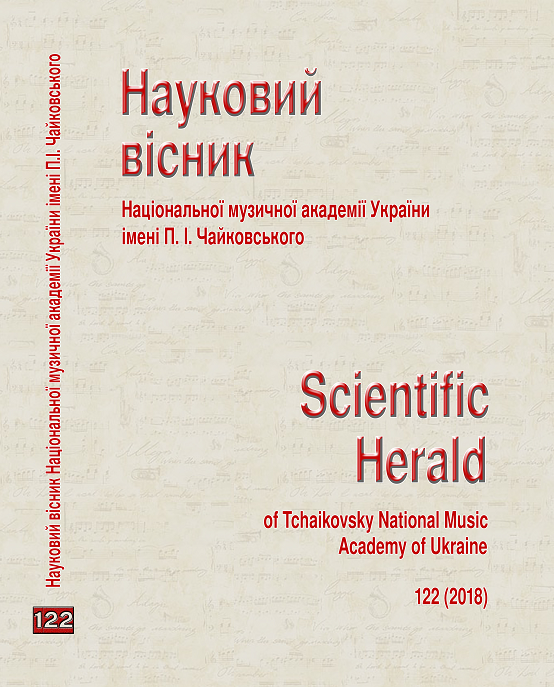The Theory of Heinrich Christoph Koch and its role in the context of the analysis of musical works
DOI:
https://doi.org/10.31318/2522-4190.2018.122.141854Keywords:
Heinrich Christoph Koch, musical theory, analysis of a musical work, entries from the Musical lexiconAbstract
The relevance of the research. The musical theory of Heinrich Christoph Koch can serve as an example of an analytical music method that does not need to borrow methods and terminology from other sciences, as today is popular in the scientific discourse that relates to the analysis of a musical work. Definitions which are considered from the Musical Lexicon (Musikalisches Lexikon) are related to the musical form, the analysis of a musical piece, as well as its understanding from the composer's viewpoint, beginning from his idea, through its development, right up to its realization. The aesthetic perception of a musical work – expressed through its elements and structure – is extremely important to Koch. Purpose of the paper. The purpose of the paper is the possible actualization of the analytical terminology from the Koch’s musical theory in modern analytical practice. Methods of research. The entries from the Musical Lexicon – which are the subject of consideration in this paper – are classified into two groups, in an overestimation from the way they are treated to a musical work. The first is connected with the idea and the plan of the musical piece and in it the Koch’s viewpoint to it (the piece) from the creative side is represented. The second group collected terms that relate to dissection, through which the work is viewed from an analytical point of view.
Conclusions. Analytical terminology of Heinrich Christoph Koch is more suitable for analyzing Baroque musical forms of free (gallant) style because a lot of terms are used to analyze the same segment of a musical piece depending on what prevails in it (rhythm, melody, function, structure). This variety will provide a better analysis of a piece whose meaning is unavailable exclusively from the thematism, the concept on which most textbooks in musical form are written, and which is applicable to music, starting from Romanticism.
Practical significance. This article is a part of a wider research with the goal of introducing this analytical terminology into today's practice, especially to find the best analytical approach to music of Baroque and Classicism.
Downloads
References
Mazel, L. (1979), Structure of musical works, 2nd ed., Muzyka, Moscow, 536 p. [in Russian]
Holopov, Yu. (1985), “To the problem of musical analysis”, Problemyi muzyikalnoy nauki [Problems of musical science], vol. 6, Sovetskiy kompozitor, Moscow, p. 130-151 [in Russian].
Holopov Yu., Kirillina L., Kyuregyan T., Lyizhov G., Pospelova R. & Tsenova V. (2006), Musical-theoretical systems, Izdatelskiy dom «Kompozitor», Moscow, 632 p. [in Russian].
Koch, Heinrich Christoph. Musikalisches Lexikon. Frankfurt am Main, 1802. URL: https://imslp.org/wiki/Musikalisches_Lexikon_(Koch,_Heinrich_Christoph) (дата обращения 25.04.2017) [in German].
Кovaleff Baker, Nancy & Thomas Christensen (1995), “Aesthetics and the Art of Musical Composition in the German Enlightenment”, Selected Writings of Johann Georg Sulzer and Heinrich Christoph Koch, Cambridge, 224 p. [in English].
Кovaleff Baker, Nancy (1983), Heinrich Christoph Koch: Introductory Essay on Composition. The Mechanical Rules of Melody, Sections 3 and 4 (transl. Nancy Kovaleff Baker). New Haven and London, 259 p. [in English].
Perkovic Radak, I. (2008), “The Process of creation of a musical piece. From the writings of musical theorists of the Age of Enlightment (Johann Georg Sulzer and Heinrich Christoph Koch)”, Collection of the Chair of Musical Theory : Musical theory and analysis 5. Belgrade, p. 1- 17 [in Serbian].
Downloads
Published
How to Cite
Issue
Section
License
Our journal abides by the CREATIVE COMMONS copyright rights and permissions for open access journals.
Authors, who are published in this journal, agree to the following conditions:
The authors reserve the right to authorship of the work and pass the first publication right of this work to the journal under the terms of a Creative Commons Attribution License, which allows others to freely distribute the published research with the obligatory reference to the authors of the original work and the first publication of the work in this journal.
The authors have the right to conclude separate supplement agreements that relate to non-exclusive work distribution in the form in which it has been published by the journal (for example, to upload the work to the online storage of the journal or publish it as part of a monograph), provided that the reference to the first publication of the work in this journal is included.




